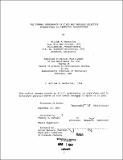The thermal performance of fixed and variable selective transmitters in commercial architecture
Author(s)
Bartovics, William A
DownloadFull printable version (7.536Mb)
Alternative title
Thermal benefits of switchable glazing strategies
Other Contributors
Massachusetts Institute of Technology. Dept. of Architecture.
Advisor
Timothy E. Johnson.
Terms of use
Metadata
Show full item recordAbstract
A parametric model is developed for use in evaluating the relative thermal and lighting performance of a variety of existing and proposed types of commercial glazing materials. The glazing materials considered are divided into three general categories: (a) traditional glass of both clear and reflectorized types; (b) glazings with selective transmission properties of the fixed variety which largely reflect the invisible portion of the solar spectrum and contain only heat and which establish a range of operating cost bases; and (c) newly proposed electro-chromic glazing materials which variable transmit both the heat and daylight portions of the solar spectrum. This parametric model is based on comparisons of total annual energy consumption for a typical perimeter office in a multi-story office building situated in a variety of cities in the continental U.S..areas of reasonably dense commercial development within the continental U.S. The results of the simulations showed a handsome potential savings, over several standard glazing types, for selective transmitters of both the fixed and switchable variety. Fixed transmitters were also excellent performers,several configurations offering savings often only slightly lower than the highest savings attained in the switchable group. The switchable transmitter group contained glazings which produced the lowest annual loads. The primary reductions were made in cooling loads without dramatic increases in lighting loads, but heating savings, resulting primarily from glazing materials of high thermal resistance, proved to be significant in cold climates.
Description
Thesis (M.S.)--Massachusetts Institute of Technology, Dept. of Architecture, 1984. MICROFICHE COPY AVAILABLE IN ARCHIVES AND ROTCH. Includes bibliographical references (p. 137-138).
Date issued
1984Department
Massachusetts Institute of Technology. Department of ArchitecturePublisher
Massachusetts Institute of Technology
Keywords
Architecture.